一,Thymeleaf 简介
Thymeleaf 是一个跟 Velocity、FreeMarker 类似的模板引擎,它可以完全替代 JSP 。相较与其他的模板引擎,它有如下三个极吸引人的特点:
1,Thymeleaf 在有网络和无网络的环境下皆可运行,即它可以让美工在浏览器查看页面的静态效果,也可以让程序员在服务器查看带数据的动态页面效果。这是由于它支持 html 原型,然后在 html 标签里增加额外的属性来达到模板+数据的展示方式。浏览器解释 html 时会忽略未定义的标签属性,所以 thymeleaf 的模板可以静态地运行;当有数据返回到页面时,Thymeleaf 标签会动态地替换掉静态内容,使页面动态显示。
2,Thymeleaf 开箱即用的特性。它提供标准和spring标准两种方言,可以直接套用模板实现JSTL、 OGNL表达式效果,避免每天套模板、该jstl、改标签的困扰。同时开发人员也可以扩展和创建自定义的方言。
3.,Thymeleaf 提供spring标准方言和一个与 SpringMVC 完美集成的可选模块,可以快速的实现表单绑定、属性编辑器、国际化等功能。
二,Hello Thymeleaf实例
1,创建Maven项目
具体步骤参照:Eclipse中创建Maven Web项目
2,添加Spring的依赖
具体步骤参考:Maven创建Spring MVC项目
3,修改pom.xml文件,加入Thymeleaf
<!-- thymeleaf模板引擎 --> <dependency> <groupId>org.thymeleaf</groupId> <artifactId>thymeleaf</artifactId> <version>2.1.4.RELEASE</version> </dependency> <dependency> <groupId>org.thymeleaf</groupId> <artifactId>thymeleaf-spring4</artifactId> <version>2.1.4.RELEASE</version> </dependency>
4,在Spring MVC配置文件中添加thymeleaf视图解释器
<!-- 视图解析器 --> <!-- 使用thymeleaf解析 --> <bean id="templateResolver" class="org.thymeleaf.spring4.templateresolver.SpringResourceTemplateResolver"> <property name="prefix" value="/WEB-INF/views/" /> <property name="suffix" value=".html" /> <property name="templateMode" value="HTML5" /> <!-- 缓存--> <property name="cacheable" value="false"/> </bean> <bean id="templateEngine" class="org.thymeleaf.spring4.SpringTemplateEngine"> <property name="templateResolver" ref="templateResolver" /> </bean> <bean class="org.thymeleaf.spring4.view.ThymeleafViewResolver"> <property name="templateEngine" ref="templateEngine" /> <!--解决中文乱码--> <property name="characterEncoding" value="UTF-8"/> </bean>
关闭Thymeleaf页面的缓存,可以让对页面的改动及时反映到视图中。
5,创建一个页面
html页面标签中引入如下:
<html xmlns:th="http://www.thymeleaf.org">
具体html页面如下:
<!DOCTYPE html> <html lang="zh-CN" xmlns="http://www.w3.org/1999/xhtml" xmlns:th="http://www.thymeleaf.org"> <head> <meta charset="UTF-8"/> <title>index</title> </head> <body> Hello Thymeleaf! </body> </html>
6,创建一个Controller
@Controller @RequestMapping("/index") public class IndexController { @RequestMapping("returnString") public String returnString(){ return "index"; } }
7,运行项目访问IndexController

三,页面参数获取/回显
1,创建一个pojo
public class Person { private int id; private String name; private String addrs; public Person(int id, String name, String addrs) { super(); this.id = id; this.name = name; this.addrs = addrs; } public Person() { super(); } public int getId() { return id; } public void setId(int id) { this.id = id; } public String getName() { return name; } public void setName(String name) { this.name = name; } public String getAddrs() { return addrs; } public void setAddrs(String addrs) { this.addrs = addrs; } @Override public String toString() { return "Person [id=" + id + ", name=" + name + ", addrs=" + addrs + "]"; } }
2,创建提交表单页面person.html
<!DOCTYPE html> <html lang="zh-CN" xmlns="http://www.w3.org/1999/xhtml" xmlns:th="http://www.thymeleaf.org"> <head> <meta charset="UTF-8"/> <title>person</title> <link href="css/bootstrap.css" rel="stylesheet"/> <script src="js/jquery-3.2.1.js"></script> <script src="js/bootstrap.js"></script> </head> <body> <form th:action="@{savePerson}" th:method="post"> <div class="form-group"> <label class="col-sm-2 control-label">id</label> <div class="col-sm-10"> <input type="text" class="form-control" name="id" placeholder="id" /> </div> </div> <div class="form-group"> <label class="col-sm-2 control-label">名称</label> <div class="col-sm-10"> <input type="text" class="form-control" name="name" placeholder="name" /> </div> </div> <div class="form-group"> <label class="col-sm-2 control-label">地址</label> <div class="col-sm-10"> <input type="text" class="form-control" name="addrs" placeholder="addrs" /> </div> </div> <div class="form-group"> <div class="col-sm-offset-2 col-sm-10"> <button type="submit" class="btn btn-default">提交</button> </div> </div> </form> </body> </html>
解释:
|
th:action属性 |
表示其值代替静态页面的action的值。等价action='/savePerson'。 |
|
th:method属性 |
表示其值将代替静态页面的method的值。等价method='post'。 |
3,创建回显页面return.html
<!DOCTYPE html> <html lang="zh-CN" xmlns="http://www.w3.org/1999/xhtml" xmlns:th="http://www.thymeleaf.org"> <head> <meta charset="UTF-8"/> <title>return</title> <link href="css/bootstrap.css" rel="stylesheet"/> <script src="js/jquery-3.2.1.js"></script> <script src="js/bootstrap.js"></script> </head> <body> <!-- from表单获取提交过来的数据 --> <h3>from表单获取提交过来的数据</h3> <form th:action="@{savePerson}" th:method="post" th:object="${person}"> <div class="form-group"> <label class="col-sm-2 control-label">id</label> <div class="col-sm-10"> <input type="text" class="form-control" name="id" placeholder="id" th:value="*{id}"/> </div> </div> <div class="form-group"> <label class="col-sm-2 control-label">名称</label> <div class="col-sm-10"> <input type="text" class="form-control" name="name" placeholder="name" th:value="*{name}"/> </div> </div> <div class="form-group"> <label class="col-sm-2 control-label">地址</label> <div class="col-sm-10"> <input type="text" class="form-control" name="addrs" placeholder="addrs" th:value="*{addrs}"/> </div> </div> <div class="form-group"> <div class="col-sm-offset-2 col-sm-10"> <button type="submit" class="btn btn-default">提交</button> </div> </div> </form> <!-- 表格获取提交过来的数据 --> <h3>表格获取提交过来的数据 </h3> <table class="table" th:object="${person}"> <tr> <td>id</td> <td>name</td> <td>addrs</td> </tr> <tr> <td th:text="${person.id}"></td> <td th:text="${person.name}"></td> <td th:text="${person.addrs}"></td> </tr> </table> </body> </html>
解释:
|
th:object属性 |
表示有一个属性名为"person"的Java bean传递到页面上来。可以通过表达式*{fieldName}才能取得其值。 |
|
th:value属性 |
表示取得Person实例中的属性值,也就是通过调用Java bean的get方法获得。等价于标签value='xxx' |
|
th:text属性 |
文本显示。等价于标签text='xxx' |
4,创建PersonController
@Controller public class PersonController { @RequestMapping public String returnString(){ return "person"; } @RequestMapping("/savePerson") public String savePerson(Model Model ,Person person){ Model.addAttribute("person", person); return "return"; } }
运行访问:http://localhost:8081/Thymeleaf/,点击提交
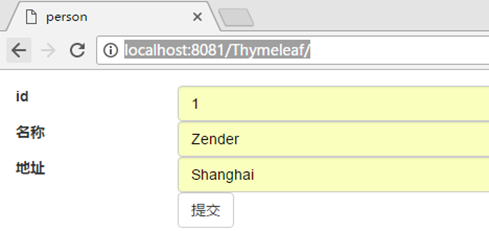
运行结果:

四,基本表达式
1,${}
变量表达式(美元表达式),用于访问容器上下文环境中的数据,功能与jstl中${}的相同。
<td th:text="${person.id}"></td> <td th:text="${person.name}"></td> <td th:text="${person.addrs}"></td>
2,*{}
选择表达式(星号表达式),获取选定对象里的数据域(th:object属性用于绑定对象)。
选择表达式与变量表达式的区别:
选择表达式计算的是选定的对象,而不是整个环境变量映射。也就是:只要是没有选择的对象,选择表达式与变量表达式的语法是完全一样的。
<!-- from表单获取提交过来的数据 --> <h3>from表单获取提交过来的数据</h3> <form th:action="@{savePerson}" th:method="post" th:object="${person}"> <div class="form-group"> <label class="col-sm-2 control-label">id</label> <div class="col-sm-10"> <input type="text" class="form-control" name="id" placeholder="id" th:value="*{id}"/> </div> </div> <div class="form-group"> <label class="col-sm-2 control-label">名称</label> <div class="col-sm-10"> <input type="text" class="form-control" name="name" placeholder="name" th:value="*{name}"/> </div> </div> <div class="form-group"> <label class="col-sm-2 control-label">地址</label> <div class="col-sm-10"> <input type="text" class="form-control" name="addrs" placeholder="addrs" th:value="*{addrs}"/> </div> </div> <div class="form-group"> <div class="col-sm-offset-2 col-sm-10"> <button type="submit" class="btn btn-default">提交</button> </div> </div> </form>
3,#{}
没明白怎么使用!自己测试不出来。希望看见的大佬能指点迷津。
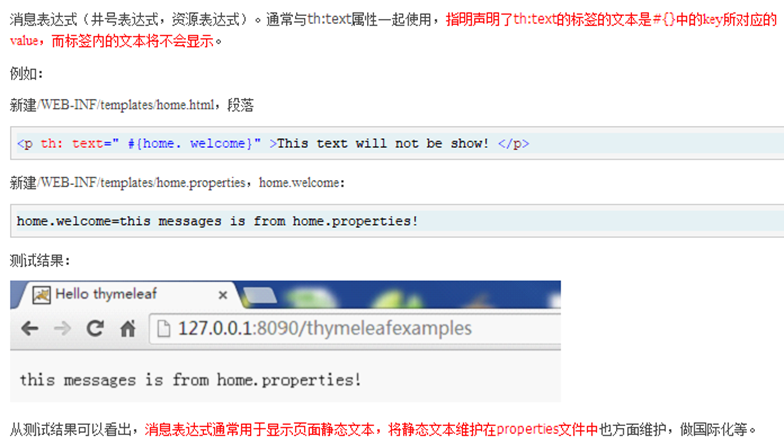
4,@{}
超链接url表达式。
<script th:src="@{/js/jquery/jquery.js}"></script>
五,常用属性
1,th:action
定义后台控制器路径,类似<form>标签的action属性。
2,th:each
对象遍历,功能类似jstl中的<c:forEach>标签
Controller
@RequestMapping("/listPerson")
public String listPerson(Model Model){
List<Person> list = new ArrayList<Person>();
list.add(new Person(1, "Zender", "Shanghai"));
list.add(new Person(2, "Zender2", "Shanghai2"));
list.add(new Person(3, "Zender3", "Shanghai3"));
Model.addAttribute("listPerson", list);
return "listPerson";
}
页面
<head> <meta charset="UTF-8"/> <title>listPerson</title> <link th:href="@{/css/bootstrap.css}" rel="stylesheet"/> <script th:src="@{/js/jquery-3.2.1.js}"></script> <script th:src="@{/js/bootstrap.js}"></script> </head> <body> <h3>each循环</h3> <table class="table"> <tr> <td>id</td> <td>name</td> <td>addrs</td> </tr> <tbody th:each="person,personStat:${listPerson}"> <tr> <td th:text="${person.id}"></td> <td th:text="${person.name}"></td> <td th:text="${person.addrs}"></td> </tr> </tbody> </table> </body> </html>
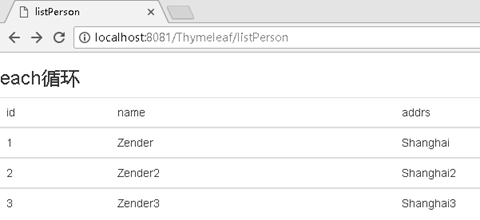
personStat称作状态变量,属性有:
|
index |
当前迭代对象的index(从0开始计算)。 |
|
count |
当前迭代对象的index(从1开始计算)。 |
|
size |
被迭代对象的大小。 |
|
current |
当前迭代变量。 |
|
even/odd |
布尔值,当前循环是否是偶数/奇数(从0开始计算)。 |
|
first |
布尔值,当前循环是否是第一个。 |
|
last |
布尔值,当前循环是否是最后一个。 |
3,th:field
常用于表单字段绑定。通常与th:object一起使用。 属性绑定、集合绑定。
Controller
@RequestMapping("/person")
public String returnString(){
return "person";
}
@RequestMapping("/savePerson")
public String savePerson(Model Model ,Person person){
Model.addAttribute("person", person);
return "return";
}
表单页面
<form th:action="@{savePerson}" th:method="post"> <div class="form-group"> <label class="col-sm-2 control-label">id</label> <div class="col-sm-10"> <input type="text" class="form-control" name="id" placeholder="id" /> </div> </div> <div class="form-group"> <label class="col-sm-2 control-label">名称</label> <div class="col-sm-10"> <input type="text" class="form-control" name="name" placeholder="name" /> </div> </div> <div class="form-group"> <label class="col-sm-2 control-label">地址</label> <div class="col-sm-10"> <input type="text" class="form-control" name="addrs" placeholder="addrs" /> </div> </div> <div class="form-group"> <div class="col-sm-offset-2 col-sm-10"> <button type="submit" class="btn btn-default">提交</button> </div> </div> </form>
回显页面
<!-- from表单获取提交过来的数据 --> <h3>from表单获取提交过来的数据</h3> <form th:action="@{savePerson}" th:method="post" th:object="${person}"> <div class="form-group"> <label class="col-sm-2 control-label">id</label> <div class="col-sm-10"> <input type="text" class="form-control" name="id" placeholder="id" th:field="*{id}"/> </div> </div> <div class="form-group"> <label class="col-sm-2 control-label">名称</label> <div class="col-sm-10"> <input type="text" class="form-control" name="name" placeholder="name" th:field="*{name}"/> </div> </div> <div class="form-group"> <label class="col-sm-2 control-label">地址</label> <div class="col-sm-10"> <input type="text" class="form-control" name="addrs" placeholder="addrs" th:field="*{addrs}"/> </div> </div> <div class="form-group"> <div class="col-sm-offset-2 col-sm-10"> <button type="submit" class="btn btn-default">提交</button> </div> </div> </form>
4,th:href
定义超链接。
<link th:href="@{/css/bootstrap.css}" rel="stylesheet"/>
5,th:id
id声明,类似html标签中的id属性。
<div th:id="ids"></div>
6,th:if,th:unless
th:if条件判断,th:if中条件成立时才显示。
th:unless于th:if恰好相反,表达式中的条件不成立,才会显示其内容。
<div th:if="${person.id} == 0">123</div>
7,th:include,th:replace和th:fragment
|
th:fragment |
布局标签,定义一个代码片段,方便其它地方引用。常与th:include,th:replace一起使用。 |
|
th:include |
布局标签,替换内容到引入的文件。 |
|
th:replace |
布局标签,替换整个标签到引入的文件。 |
模板文件footer.html:
<div th:fragment="footer" > Copyright ©2018 Zender </div> <div th:fragment="head" > 头部 Zender </div>
页面index.html
<body> <div th:include="../templates/footer :: head"></div> Hello Thymeleaf! <div th:include="../templates/footer :: footer"></div> </body>
文件路径
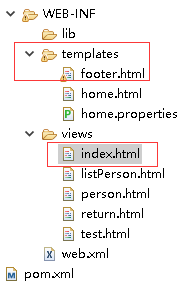
访问
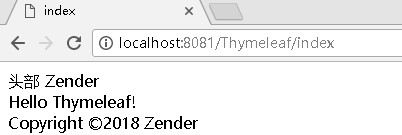
8,th:src
用于外部资源引入,类似于<script>标签的src属性,常与@{}一起使用。
<script th:src="@{/js/jquery-3.2.1.js}"></script>
9,th:text
文本显示。
<td class="text" th:text="${username}" ></td>
10,th:value
用于标签复制,类似<option>标签的value属性。
<input type="text" class="form-control" name="name" placeholder="name" th:value="*{name}"/>
11,th:switch
默认属性default可以用*表示。
<div th:switch="${user.role}"> <p th:case="'admin'">User is an administrator</p> <p th:case="#{roles.manager}">User is a manager</p> <p th:case="*">User is some other thing</p> </div>
常用属性表格:
|
关键字 |
功能介绍 |
案例 |
|
th:id |
替换id |
<input th:id="'xxx' + ${collect.id}"/> |
|
th:text |
文本替换 |
<p th:text="${collect.description}">description</p> |
|
th:utext |
支持html的文本替换 |
<p th:utext="${htmlcontent}">conten</p> |
|
th:object |
替换对象 |
<div th:object="${session.user}"> |
|
th:value |
属性赋值 |
<input th:value="${user.name}" /> |
|
th:with |
变量赋值运算 |
<div th:with="isEven=${prodStat.count}%2==0"></div> |
|
th:style |
设置样式 |
th:style="'display:' + @{(${sitrue} ? 'none' : 'inline-block')} + ''" |
|
th:onclick |
点击事件 |
th:onclick="'getCollect()'" |
|
th:each |
属性赋值 |
tr th:each="user,userStat:${users}"> |
|
th:if |
判断条件 |
<a th:if="${userId == collect.userId}" > |
|
th:unless |
和th:if判断相反 |
<a th:href="@{/login}" th:unless=${session.user != null}>Login</a> |
|
th:href |
链接地址 |
<a th:href="@{/login}" th:unless=${session.user != null}>Login</a> /> |
|
th:switch |
多路选择 配合th:case 使用 |
<div th:switch="${user.role}"> |
|
th:case |
th:switch的一个分支 |
<p th:case="'admin'">User is an administrator</p> |
|
th:fragment |
布局标签,定义一个代码片段,方便其它地方引用 |
<div th:fragment="alert"> |
|
th:include |
布局标签,替换内容到引入的文件 |
<head th:include="layout :: htmlhead" th:with="title='xx'"></head> /> |
|
th:replace |
布局标签,替换整个标签到引入的文件 |
<div th:replace="fragments/header :: title"></div> |
|
th:selected |
selected选择框 选中 |
th:selected="(${xxx.id} == ${configObj.dd})" |
|
th:src |
图片类地址引入 |
<img class="img-responsive" alt="App Logo" th:src="@{/img/logo.png}" /> |
|
th:inline |
定义js脚本可以使用变量 |
<script type="text/javascript" th:inline="javascript"> |
|
th:action |
表单提交的地址 |
<form action="subscribe.html" th:action="@{/subscribe}"> |
|
th:remove |
删除某个属性 |
<tr th:remove="all"> 1.all:删除包含标签和所有的孩子。2.body:不包含标记删除,但删除其所有的孩子。3.tag:包含标记的删除,但不删除它的孩子。4.all-but-first:删除所有包含标签的孩子,除了第一个。5.none:什么也不做。这个值是有用的动态评估。 |
|
th:attr |
设置标签属性,多个属性可以用逗号分隔 |
比如 th:attr="src=@{/image/aa.jpg},title=#{logo}",此标签不太优雅,一般用的比较少。 |